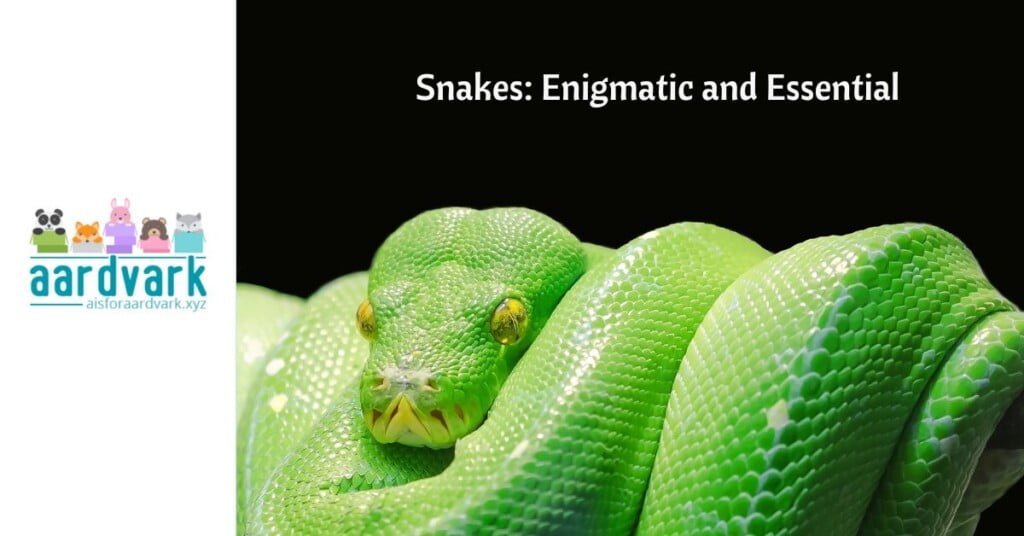Snakes, one of the most diverse and widely distributed groups of reptiles, have long captivated – and terrified – human imagination with their unique biology and behaviors. They play crucial roles in many ecosystems around the globe. This article aims to explore the fascinating world of snakes, touching on their commonalities and diversity.
Taxonomy and Diversity
Snakes belong to the suborder Serpentes, part of the order Squamata, alongside lizards and amphisbaenians. With over 3,000 species, snakes exhibit a remarkable range of sizes, shapes, and colors, adapted to environments as varied as dense rainforests, arid deserts, freshwater lakes, and oceans. They can be found everywhere except Antarctica, showcasing their incredible adaptability.
Habitats
Snakes inhabit a variety of ecological niches. The arboreal green tree python (Morelia viridis) lives in the canopies of New Guinea and Australia. The sidewinder (Crotalus cerastes) is perfectly adapted to the shifting sands of North American deserts. Aquatic species like the anaconda (Eunectes murinus) can be found in the waterways of South America, demonstrating snakes’ capacity to thrive in terrestrial and aquatic environments.
Physical Characteristics and Adaptations
Snakes are legless reptiles with elongated bodies, a morphology that aids in their various modes of locomotion, such as slithering, swimming, and, in the case of the paradise tree snake (Chrysopelea paradisi), gliding through the air. They possess a range of adaptations that suit their predatory lifestyle, including flexible jaws that allow them to consume prey much larger than their head.
Venomous species, such as the king cobra (Ophiophagus hannah) and the black mamba (Dendroaspis polylepis), have evolved specialized glands to produce venom, a tool for subduing prey and self-defense. On the other hand, non-venomous species rely on constriction or stealth to catch their meals.
Lifestyle: Predation and Survival Strategies
Snakes are predominantly carnivorous, feeding on a diet that includes rodents, birds, insects, and other reptiles. Some larger species may even prey on mammals as big as antelopes. As we mentioned, both constriction and venom are part of the hunting gear of different species.
Camouflage plays a critical role in both predation and protection for snakes. Their often cryptic coloration allows them to blend into their surroundings, making them invisible to both prey and predators. Furthermore, some nonvenomous species mimic the appearance or behavior of venomous snakes to deter threats, a strategy known as Batesian mimicry.
The Role of Snakes in Ecosystems
Snakes contribute significantly to the balance of their ecosystems. As predators, they help control populations of rodents and other animals, preventing overgrazing and the spread of disease. Additionally, snakes are prey for various other predators, including birds of prey, mammals, and even other snakes, making them integral to the food web.
Breeding Behaviors and Lifecycle
Snake reproduction strategies vary widely among species, showcasing the adaptability and diversity of these reptiles. Many snakes are oviparous, laying eggs in carefully selected, temperature-regulated environments. Examples include the common garter snake (Thamnophis sirtalis) and the king cobra (Ophiophagus hannah), the latter known for the female’s unique behavior of building a nest for her eggs—a rare trait among snakes.
Conversely, some species are ovoviviparous or viviparous, giving birth to live young. This adaptation is particularly advantageous in cooler climates, where maintaining the temperature of a nest is challenging. The boa constrictor (Boa constrictor) and the green anaconda (Eunectes murinus) are well-known examples, giving birth to fully formed young ready to fend for themselves.
Regardless of the method, snake offspring are generally independent from birth, equipped with instincts for hunting and self-defense. Maternal care, beyond egg protection in some species, is rare.
Snakes in Human Culture
Snakes have been a part of human mythology, religion, and folklore for millennia, symbolizing everything from fertility and rebirth to evil and temptation. In ancient Egyptian culture, the cobra was revered as a protector of the pharaoh. At the same time, in Greek mythology, snakes were associated with Asclepius, the god of medicine, symbolizing healing and rejuvenation.
In modern times, snakes continue to fascinate and inspire fear, often appearing as villains in films and literature. However, they are also popular pets, admired for their beauty and the challenge of their care. Educational programs and conservation efforts have begun to shift the public’s perception, highlighting the importance of snakes in natural ecosystems and promoting a more respectful and informed coexistence.
Threats to Snake Populations
Snakes face numerous threats from both natural and human-induced changes to their environments. Habitat destruction, caused by agricultural expansion, urban development, and deforestation, poses the most significant risk, fragmenting populations and reducing available resources. Climate change also affects snake populations by altering the availability of prey and suitable habitats.
Furthermore, snakes are often subjected to persecution due to fear and misunderstanding. Venomous species, in particular, are targeted out of concern for human safety despite their crucial role in controlling pest populations and their relatively low threat to humans when left undisturbed.
The illegal wildlife trade represents another significant threat, with many species sought for pets, skin, and traditional medicine. This trade not only depletes wild populations but also subjects snakes to inhumane conditions.
Conservation efforts for snakes are as diverse as the species themselves, ranging from habitat protection and restoration to anti-poaching measures and public education campaigns. Initiatives like creating protected areas and wildlife corridors help preserve critical habitats. Research into snake venom contributes to medical advances, increasing public appreciation for these animals.
Snakes are an incredibly diverse and important group of reptiles, playing essential roles in the balance of ecosystems worldwide. Despite the challenges they face, ongoing conservation efforts and a growing public interest in wildlife and ecology offer hope for their future. As we continue to learn about and understand these remarkable creatures, we can better appreciate their value and work towards ensuring their survival for generations to come.


